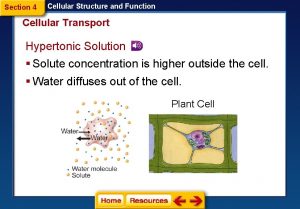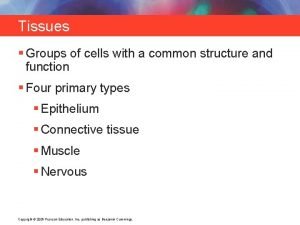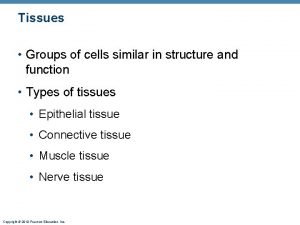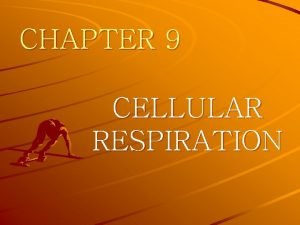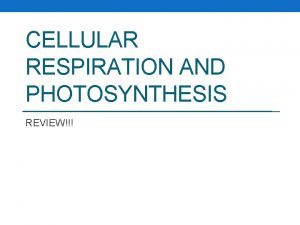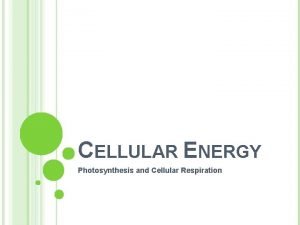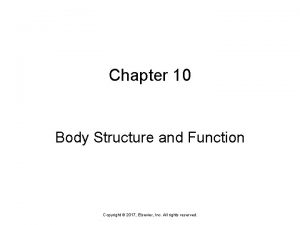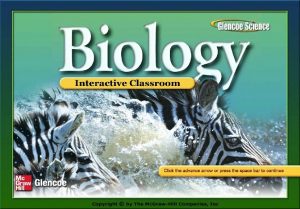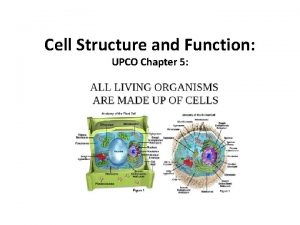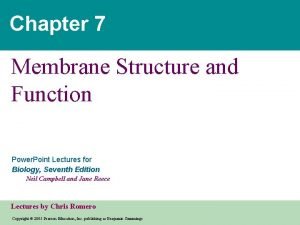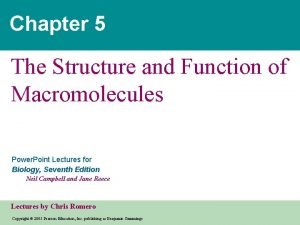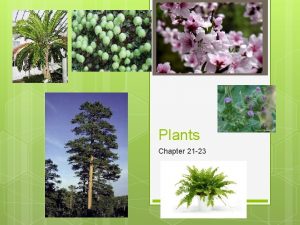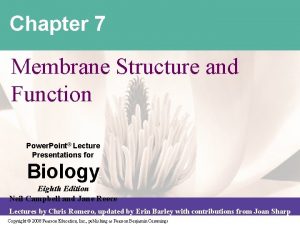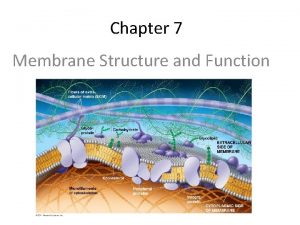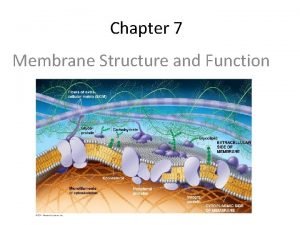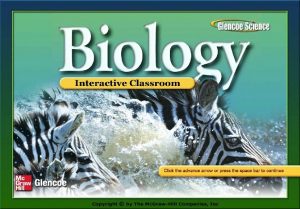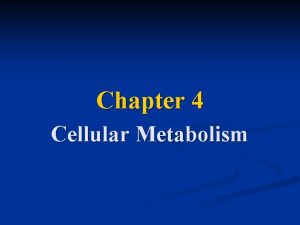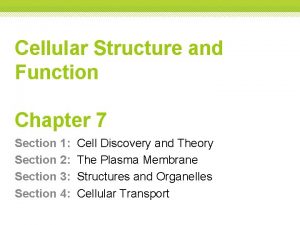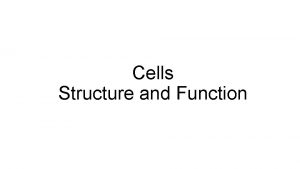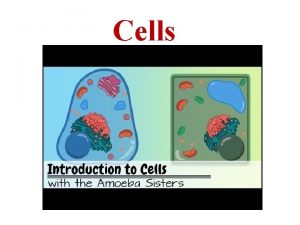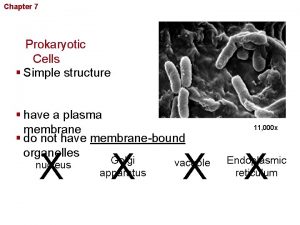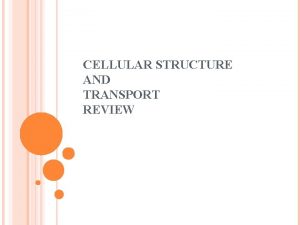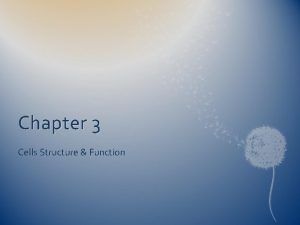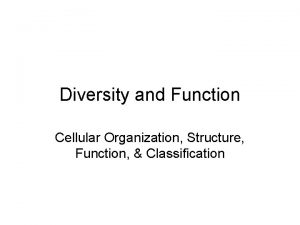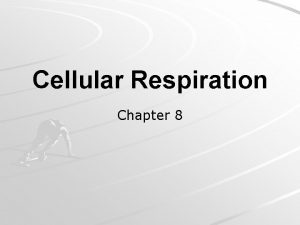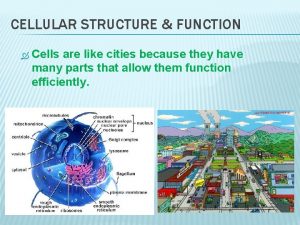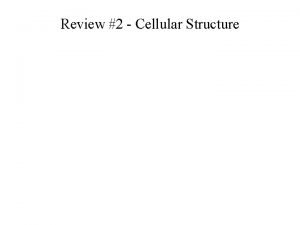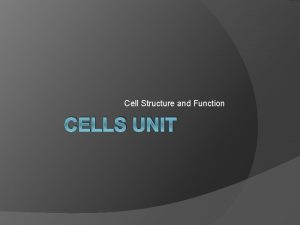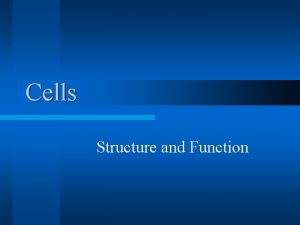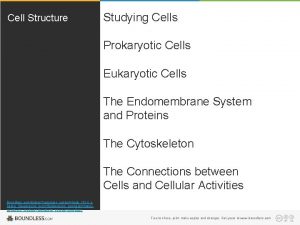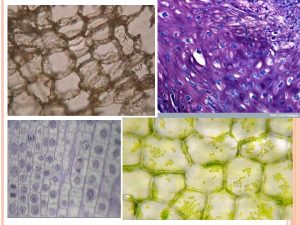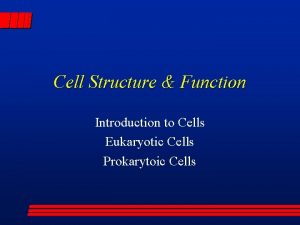Cells Chapter 7 Cellular Structure and Function 7









































- Slides: 41

Cells

Chapter 7 Cellular Structure and Function 7. 1 Cell Discovery and Theory The Cell Theory § All organisms are composed of one or more cells. § The cell is the basic unit of structure and organization of organisms. § All cells come from preexisting cells.

Chapter 7 Cellular Structure and Function 7. 1 Cell Discovery and Theory Light Microscopes § Utilizes a series of glass lenses and visible light to magnify an image § Magnifies images up to 1, 000 times the actual size

Chapter 7 Cellular Structure and Function 7. 1 Cell Discovery and Theory Electron Microscopes § Utilizes magnets to aim a beam of electrons to produce an image § Magnifies images up to 500, 000 times the actual size 9560 x

Chapter 7 Cellular Structure and Function 7. 1 Cell Discovery and Theory Prokaryotic Cell § Simple structure § Contains a plasma membrane § Does not contain membrane-bound organelles 11, 000 x

Chapter 7 Cellular Structure and Function 7. 1 Cell Discovery and Theory Eukaryotic Cell § More complex structure § Contains a plasma membrane § Contains membranebound organelles 400 x

Eukaryotic Cells

Cells • Cells can be broken down in to 3 major regions 1. Cell membrane 2. Cytoplasm 3. Nucleus

Basic Cell Types Prokaryotes Eukaryotes • • Smaller Not as complex No nucleus No membrane bound organelles • Bacteria & most unicellular organisms Larger (up to 100 times!) More complex Nucleus Membrane bound organelles • Animals, plants, yeast & algea

Chapter 7 Cellular Structure and Function 7. 2 The Plasma Membrane Plasma (Cell) Membrane § Thin, flexible boundary between the cell and its environment § Allows nutrients into the cell § Allows waste to leave the cell

Chapter 7 Cellular Structure and Function 7. 2 The Plasma Membrane Selective Permeability § The plasma membrane controls the movement of substances into and out of the cell.

Chapter 7 Cellular Structure and Function 7. 2 The Plasma Membrane § The plasma membrane is composed of the phospholipid bilayer. § A phospholipid means: §a glycerol backbone §two fatty acid chains §a phosphate group.

Chapter 7 Cellular Structure and Function 7. 2 The Plasma Membrane Fluid Mosaic Model § The phospholipid bilayer allows other molecules to “float” in the membrane. Other Components § Proteins § Cholesterol § Carbohydrates

Chapter 7 Cellular Structure and Function 7. 2 The Plasma Membrane Proteins § Transmit signals inside the cell § Act as a support structure § Provide pathways for larger substances to enter and leave the cell

Chapter 7 Cellular Structure and Function 7. 2 The Plasma Membrane Cholesterol § Prevents fatty acid tails from sticking together

Chapter 7 Cellular Structure and Function 7. 2 The Plasma Membrane Carbohydrates § Identify chemical signals

Chapter 7 Cellular Structure and Function 7. 3 Structures and Organelles

Chapter 7 Cellular Structure and Function 7. 3 Structures and Organelles

Chapter 7 Cellular Structure and Function 7. 3 Structures and Organelles Cilia § Short, numerous projections that look like hairs 400 x Flagella § Longer and less numerous than cilia § Create movement with a whiplike motion 26, 367 x

Warm Up!! Pick up a small beaker and a gummy bear from the cart in the front of the room. Fill the beaker with water until it is about ¾ full. Drop in the gummy bear. In your notebook, make a hypothesis as to what you think will happen.

February 2, 2011 How do things move in to a cell? Agenda: 1. Gummi Bear Lab 2. Diffusion Demo 3. Cellular transport HW: Chapter 7 Vocabulary Terms Due Tomorrow! Georgia Performance Standard: SB 1: Cell Structure and Function

Chapter 7 Cellular Structure and Function 7. 4 Cellular Transport Passive Transport § Movement of particles across the cell membrane without using energy Three Modes of Passive Transport § Diffusion § Facilitated Diffusion § Osmosis

What is diffusion? Agenda: 1. Discuss Cellular Transport 2. Questions on Vocabulary Quiz? HW: Study for Chapter 7 Vocab for quiz TOMORROW Georgia Performance Standard: SB 1: Cell Structure and Function

Chapter 7 Cellular Structure and Function 7. 4 Cellular Transport Diffusion § Movement of particles from an area of high concentration to an area of lower concentration Diffusion Initial Conditions Low High Low

Chapter 7 Cellular Structure and Function 7. 4 Cellular Transport § Diffusion is controlled by § Temperature § Pressure § Concentration Dynamic Equilibrium § When diffusion of material into the cell equals diffusion of material out of the cell

Chapter 7 Cellular Structure and Function 7. 4 Cellular Transport Diffusion in a Cell

Chapter 7 Cellular Structure and Function 7. 4 Cellular Transport Facilitated Diffusion § Movement of materials across the plasma membrane using proteins

Chapter 7 Cellular Structure and Function 7. 4 Cellular Transport Channel Proteins Carrier Proteins

Chapter 7 Cellular Structure and Function 7. 4 Cellular Transport Osmosis § Diffusion of water across a selectively permeable membrane Three Types of Solutions § Isotonic § Hypertonic

Warm Up!! What could cause the following conditions in a cell? 1. 2. 3.

September 18, 2009 How can a solution affect tonicity? Agenda: 1. Diffusion Quiz 2. Review Diffusion 3. Work on Cell Collage 4. Hand back papers Georgia Performance Standard: SB 1: Cell Structure and Function

Chapter 7 Cellular Structure and Function 7. 4 Cellular Transport Isotonic Solution § Water and dissolved substances diffuse into and out of the cell at the same rate. Plant Cell Blood Cell 11, 397 x

Chapter 7 Cellular Structure and Function 7. 4 Cellular Transport Hypotonic Solution § Solute concentration is higher inside the cell. § Water diffuses into the cell. § BLOWS UP the cell. Plant Cell Blood Cell 13, 000 x

Chapter 7 Cellular Structure and Function 7. 4 Cellular Transport Hypertonic Solution § Solute concentration is higher outside the cell. § Water diffuses out of the cell. § SHRINKS the cell. Plant Cell Blood Cell 13, 000 x

Chapter 7 Cellular Structure and Function 7. 4 Cellular Transport Active Transport § Movement of particles across the cell membrane using energy Active Transport Using Carrier Proteins

Chapter 7 Cellular Structure and Function 7. 4 Cellular Transport Endocytosis § Process by which the cell surrounds and takes particles into the cell Exocytosis § Secretion of material out of the plasma membrane

Warm Up!! Summarize the 5 ways particles move through the cell membrane by completing the concept map on the board.

Why is cellular transport important? Agenda: 1. Review Cellular Transport 2. Cell Project 3. Review for Test 4. Return Papers **Bring book tomorrow Georgia Performance Standard: SB 1: Cell Structure and Function

How do organisms obtain energy? Agenda: 1. Discuss Schedule Changes 2. Introduce How Organisms Obtain Energy 3. Review for Test FRIDAY **Bring Book TOMORROW Georgia Performance Standard SB 1 - Students will analyze relationship between structure and function in living things SB 3 - Relationship between cellular organisms and increasing complexity


Warm Up!! Consider the equations below. Write down anything you can figure out by simply reading the equation. 1. 6 CO 2 + 6 H 2 O C 6 H 12 O 6 + 6 O 2 2. C 6 H 12 O 6 + 6 O 2 6 CO 2 +6 H 2 O
 Chapter 8 cellular reproduction cells from cells
Chapter 8 cellular reproduction cells from cells Section 4 cellular transport
Section 4 cellular transport Muscle tissue parts
Muscle tissue parts Dense regular connective
Dense regular connective A group of cells similar in structure and function
A group of cells similar in structure and function Olfactory groove keros classification
Olfactory groove keros classification Red blood cells and white blood cells difference
Red blood cells and white blood cells difference Plant cell and animal cell venn diagram
Plant cell and animal cell venn diagram Masses of cells form and steal nutrients from healthy cells
Masses of cells form and steal nutrients from healthy cells Transport maximum
Transport maximum Thyroid parafollicular cells
Thyroid parafollicular cells How are mitosis and meiosis similar
How are mitosis and meiosis similar Why dna is more stable than rna?
Why dna is more stable than rna? Prokaryote vs eukaryote worksheet
Prokaryote vs eukaryote worksheet Prokaryotic cells
Prokaryotic cells The organelle trail
The organelle trail Label
Label What animals have prokaryotic cells
What animals have prokaryotic cells Prokaryotic cells vs eukaryotic cells
Prokaryotic cells vs eukaryotic cells Cells and life lesson 1 answer key
Cells and life lesson 1 answer key What is the correct equation for cellular respiration?
What is the correct equation for cellular respiration? Function of cellular respiration
Function of cellular respiration Function of cellular respiration
Function of cellular respiration Chapter 10 body structure and function
Chapter 10 body structure and function Eukaryotic cell structure
Eukaryotic cell structure Chapter 22 plant structure and function answer key
Chapter 22 plant structure and function answer key Chapter 7 cell structure and function section review 7-2
Chapter 7 cell structure and function section review 7-2 Chapter 5 cell structure and function
Chapter 5 cell structure and function Chapter 7 membrane structure and function
Chapter 7 membrane structure and function Chapter 5 the structure and function of macromolecules
Chapter 5 the structure and function of macromolecules Chapter 21 plant structure and function
Chapter 21 plant structure and function Chapter 7 membrane structure and function
Chapter 7 membrane structure and function Flaccid cell
Flaccid cell Chapter 7 membrane structure and function
Chapter 7 membrane structure and function Section 23-4 leaves
Section 23-4 leaves Chapter 9 section 1 cellular growth
Chapter 9 section 1 cellular growth Chapter 8 section 3 cellular respiration continued
Chapter 8 section 3 cellular respiration continued Chapter 8 lesson 1 life is cellular
Chapter 8 lesson 1 life is cellular Chapter 9 section 1 cellular growth
Chapter 9 section 1 cellular growth Diffrences between plant and animal cells
Diffrences between plant and animal cells Chapter 4 cellular metabolism
Chapter 4 cellular metabolism Chapter 7 section 1 cell discovery and theory
Chapter 7 section 1 cell discovery and theory

